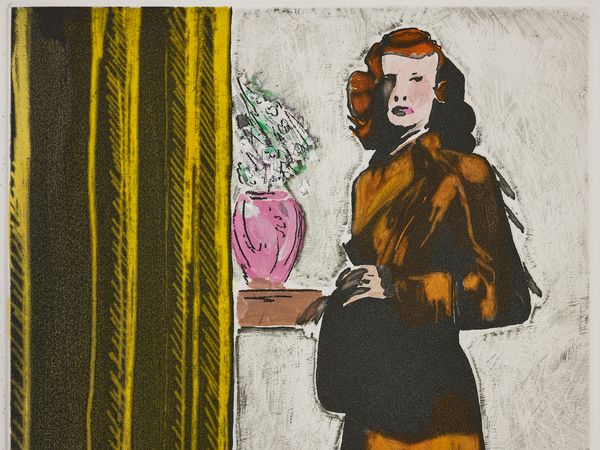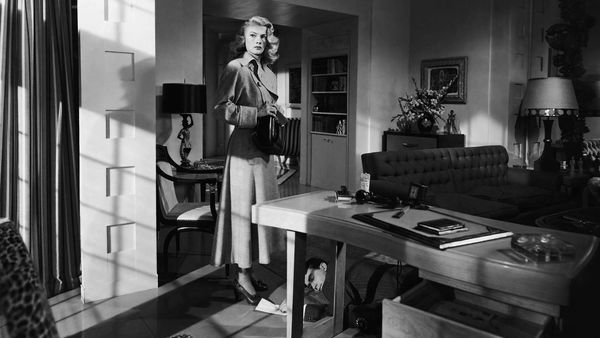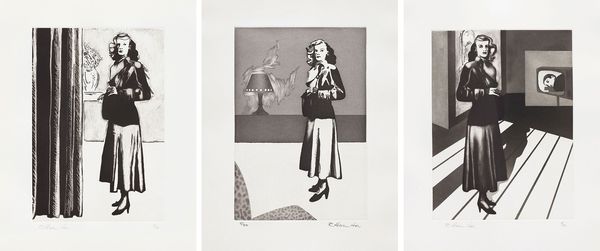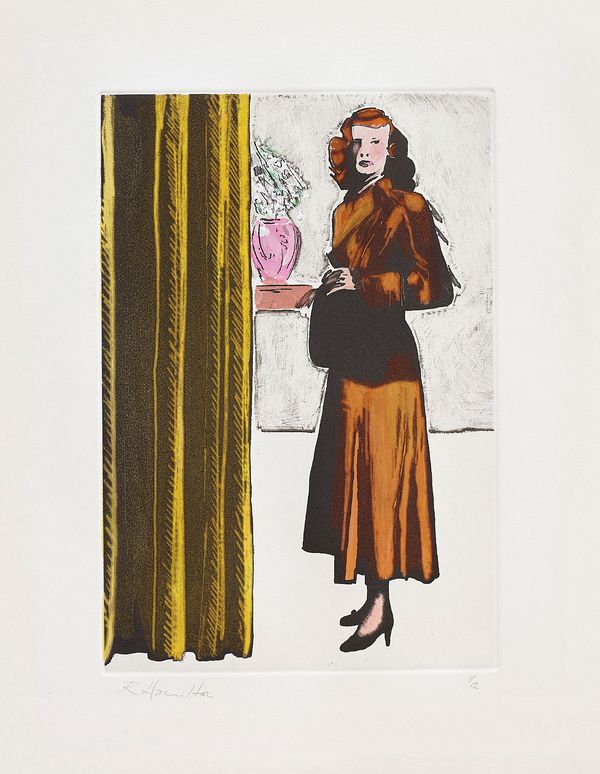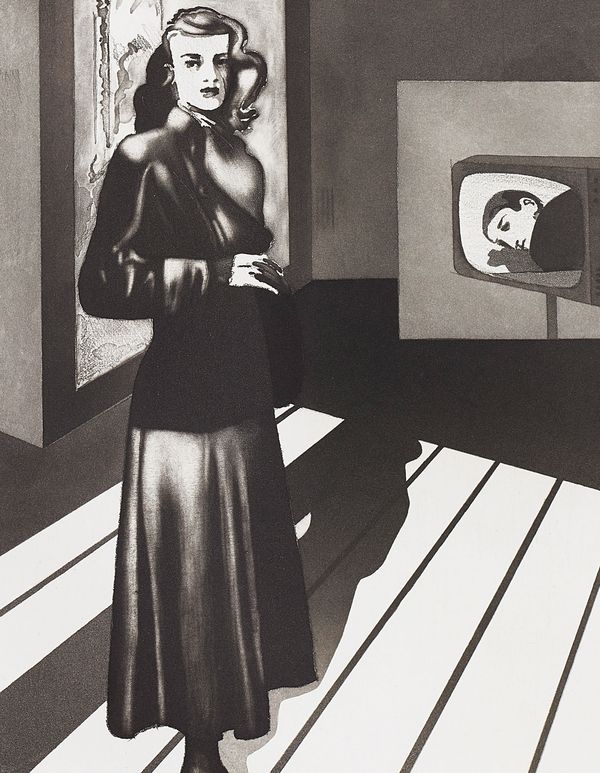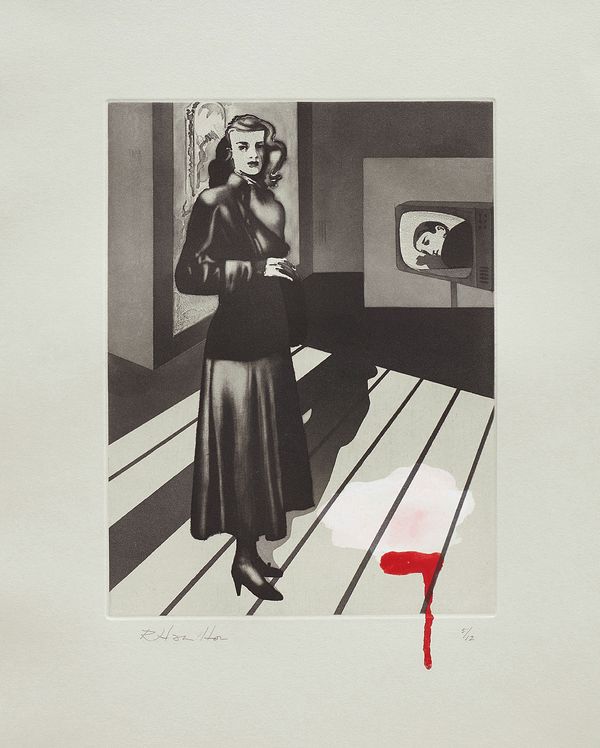Lot 19 Richard Hamilton Patricia Knight I (coloured), 1982 (detail)
Several, somewhat apocryphal stories exist telling of how Richard Hamilton first discovered the image of Patricia Knight. All versions rely on a chance encounter with the promotional poster for Douglas Sirk’s 1948, couple-on-the-run noir film, Shockproof, whether it was displayed outside a Newcastle cinema, or discarded on a classroom floor. At the time of the film’s release, it was common practice in the industry to create specially staged shots, known as ‘stills’, which were the equivalent of a trailer in print: fictive scenarios containing a host of allusions to the plot of the film.
In the still for Shockproof the leading actress, Patricia Knight, in her role as murderer-heroine, stares out past the camera with a male corpse at her feet. The construction of the room is off-kilter, seemingly assembled from different viewpoints, with distorted perspective and multiple light sources creating a sense of disquiet. A note in the dead man’s hand, the bookcase set into the wall behind her, the open desk drawer, and the telephone receiver off the hook are all clues for the viewer to decipher.
Still from the film Shockproof directed by Douglas Sirk from 1948
It is no surprise that this image, with its many implied narratives and curious, quasi-Cubist manipulation of space, captured Hamilton’s attention. The Shockproof still became a generator for a series of collages, prints and paintings including Interior I and Interior II, both 1964, that playfully used the figure of Patricia Knight and exercised Hamilton’s concerns with modes of seeing and representing an interior space. These paintings were directly preceded by a printed study, Patricia Knight, 1964, depicting the extracted figure of the actress in isolation. She stares in defiance at the viewer, clutching her purse and ready to run. Hamilton experimented with different coloured oil paints and a single photographic screen to create six prints of this image, before embarking on the painted interiors.
Richard Hamilton Patricia Knight, 1964, screenprint from one stencil on oil and pencil
It was this method of photographic screenprinting as a companion to painted works that Hamilton primarily used throughout the rest of the 1960s. However, in 1971, he was asked to produce a work for a portfolio paying homage to Pablo Picasso in celebration of his ninetieth birthday. Feeling that any homage to Picasso would have to involve "displaying respect for the masterly craftsmanship and love of the medium that Picasso demonstrated", Hamilton insisted upon working with Picasso’s master etching printer, Aldo Crommelynck. For over a decade, artist and printer intensely collaborated, fully exploring the creative opportunities that etching could offer: hard-ground, soft-ground and stipple etching, drypoint, roulette, burnishing, and an innovative variety of aquatints.
Pablo Picasso La Chèvre, 1952, sugar-lift aquatint
Whilst working at the Atelier Crommelynck, Hamilton’s eye was caught by an exquisitely simple aquatint of a goat by Pablo Picasso. Crommelynck suggested, perhaps speciously, that Picasso had created the image almost casually, with just one bite in the acid. Unable to resist the challenge implied by Crommlynck’s statement, Hamilton explained that, "Envying Picasso’s direct, fluent, easy-looking, lyrical graphic skill, I re-used an old subject just to see how he did it." The subject he chose was none other than the femme fatale, Patricia Knight.
It was the foreboding, sinister nature of the Shockproof still that so intrigued Hamilton.
Lot 20 Richard Hamilton Patricia Knight I, II, and III, 1982
The Shockproof image clearly still fascinated Hamilton, nearly twenty years on. The figure of Patricia Knight, so redolent with narrative tension and pictorial ambiguity, inspired Hamilton to create a series of three etchings, two of which he then explored further creating unique hand-coloured variants. It was the foreboding, sinister nature of the Shockproof still that so intrigued Hamilton, and in particular, how this feeling was achieved through the construction of the space and a distorted use of perspective as much as by its content or narrative.
In the three etchings, Hamilton experiments with different pictorial constructions to best convey this sense of foreboding. For Patricia Knight I he employs the use of a heavy curtain, occupying nearly a third of the plate, intentionally blocking the viewer from entering the space and making the spectator’s position illicit - almost a Peeping Tom to the scene. Hamilton used a sugar-lift aquatint to create the oppressive, velvety black of the curtain and Patricia’s jacket, before scraping away the highlights of the fabric, resulting in a cinematic chiaroscuro.
Lot 19 Richard Hamilton Patricia Knight I (coloured), 1982
Hamilton had previously enjoyed the transparency of watercolour on etchings, but to create the coloured versions of Patricia Knight I, he decided to try a more opaque acrylic pigment. The difficulty was that the acrylic paint tended to sit uncomfortably over the etched line. Together, Hamilton and Crommelynck came up with the beautiful solution of first printing the plate blind (with no ink), so that the lines bitten into the copper showed as light relief on the paper. Hamilton could then apply acrylic paint, using the impressed outline as a guide, before printing the etched black on top. The result was twelve unique variant images, each with its own colour scheme.
Lot 21 Richard Hamilton Patricia Knight II, 1982 (detail)
Beyond expanding his technical virtuosity in an attempt to match Picasso’s prowess, Hamilton stated his intent was for the etchings of Patricia Knight to be “ominous, provocative, ambiguous; a confrontation with which the spectator is familiar yet not at ease.” With Patricia Knight II, Hamilton succeeds in creating this atmosphere of unrest through the deconstruction and de-familiarisation of domestic surroundings. He provides mere hints of an interior space, the subtle delineation of a credenza enclosing the background, the very edges of an armchair encroaching upon the foreground. Yet the figure of Patricia is suspended in an undefined space, both belonging to and separated from the interior space in which she stands. The jagged lines of burnishing that emanate from the lamp seem to ominously creep towards Patricia, escalating a feeling of near Hitchcockian claustrophobia and tension.
Lot 20 Richard Hamilton Patricia Knight III (coloured), 1982
The third etching of Patricia Knight is certainly the most foreboding of all. Hamilton perhaps removed his thoughts from the technical dexterity of Picasso’s goat in order to amplify the drama of the composition, employing a full arsenal of intaglio techniques to create the stage-like interior. Patricia is shown on the left, almost directly quoting the Shockproof still, with the head of the murdered man shown on a television and the shadow of Patricia’s figure recalling his prone corpse. The dramatic bars of light echo the distorted perspective of the original image, whilst also hinting at the possible fate of jail-time for the actress’s character.
As Hamilton so wickedly describes, the image reveals "a hint of murder and the threat of punishment."—a foreboding chill that is heightened in the hand-coloured version of this etching. In the Shockproof still, the desk partly hides the body of the man Patricia Knight has just killed, but in Hamilton’s coloured version, the dramatic role of the dead man is transferred to the lurid ‘bullet wound’ of acrylic on the carpet. The red paint trickles in the margin, ready to puddle around the feet of the viewer.
Rebecca Tooby-Desmond is a Cataloguer for Modern & Contemporary Editions at Phillips in London.
